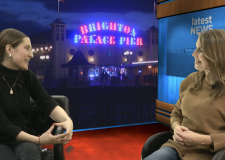Brighton academics find ‘less is more’ for children learning new words
Research by two Sussex University psychologists suggests that “less is more” for toddlers when it comes to learning new words.
They are much more successful when the learning environment stays the same, according to the newly published research.
A study by Jessica Horst and Emma Axelsson into the way children learn individual words was published online yesterday (Wednesday 3 September) in the journal Acta Psychologica.
It involved 48 three-year-old children who were introduced to names for unusual toys, such as a clacker (noisemaker).
They played a game on a touchscreen computer in which the children were asked to touch different toys to help an alien “tidy up his room”.
They heard the name of a new toy and then had to choose it from two other objects displayed on the screen.

A young child taking part in an experiment on word-learning with Dr Jessica Horst at Sussex University
Children saw familiar things such as toy cars and plush animals alongside the unusual toys.
All children heard the new words the same number of times but sometimes the familiar objects were always different and sometimes they were always the same.
For example, some children always saw the clacker with the elephant and boat and some children always saw that toy with different things.
The children who had less distraction – those who always saw things with the same other objects – learnt the words.
The children who encountered more distraction did not learn the words.
Dr Horst said: “Across developmental psychology we are seeing two big shifts in the research on how children learn.
“Several studies—including ours—are finding that less is more when it comes to learning.
“Children learn more information and learn it better when their learning environments are less distracting.
“They do not need many bells and whistles. They are naturally active learners.
“For example, recent research has found that children learn better at home when the TV is turned off and are more attentive at school when classrooms are plainly decorated.
“Our current study suggests that it can be highly beneficial for children to play with the same group of toys over and over again—as long as they are interested.
“So, for example, if your child always plays with the same pots and food within the play kitchen, this is fine.
“Children are actually really good at knowing what helps them learn.
“They’ll let us know when they are bored and when to move on to something new.
“This study also demonstrates why learning through play is so valuable for children.”
Dr Axelsson, now at Australia National University, added: “Sometimes children might just guess the meanings of words but when they do this repeatedly in the same environments, like when they guess the meaning of the word thermometer in the context of the word dummy and bottle, over time the connection between the word and object is strengthened.
“Guessing the meaning of words in a neat environment of a touchscreen can provide a supportive learning platform for children.”
The research was funded by the Economic and Social Research Council.
It builds on previous research in Dr Horst’s lab showing that children learn more words when they see fewer objects at once and that children learn more words when they hear the same stories repeatedly rather than several different stories.
Their study in Acta Psychologica is entitled “Contextual repetition facilitates word learning via fast mapping”. It was published online yesterday, with the print edition scheduled for October.




















